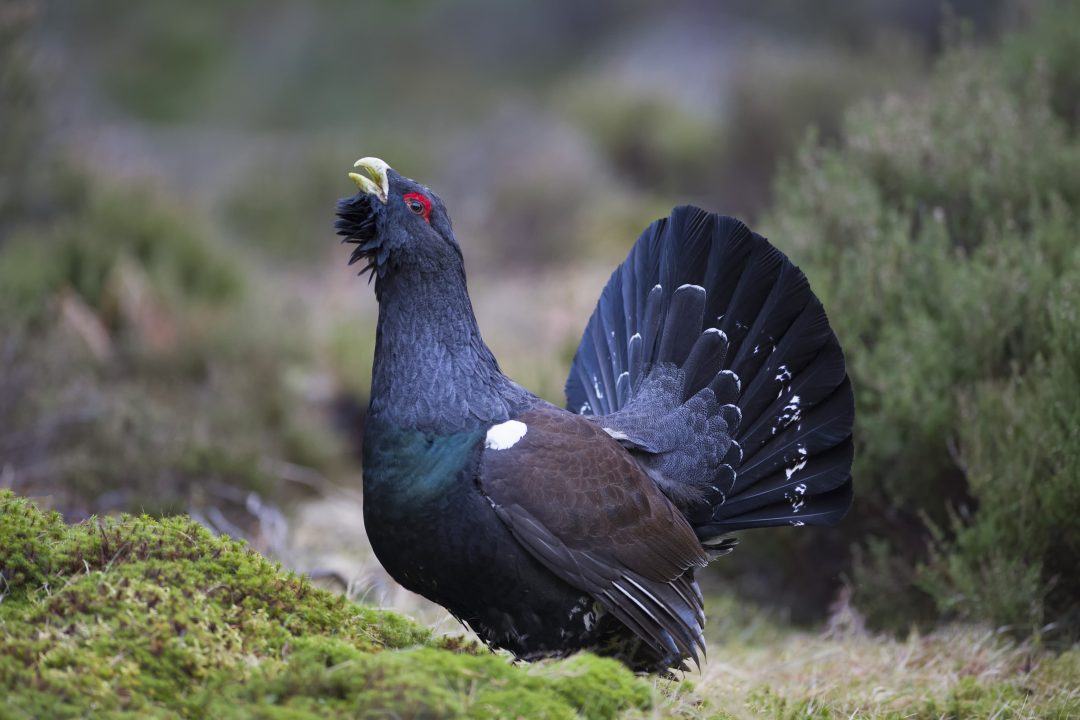Researchers have hailed the success of a predator management scheme that has doubled the number of endangered capercaillie broods in areas of Scotland where it has been deployed.
With just over 500 of the ground-nesting birds left in the wild, the capercaillie, a large woodland grouse, is in danger of extinction in the UK.
One contributor to the birds’ decline is the eating of eggs and chicks by predators – including the pine marten, another protected species.
In an effort to protect capercaillie broods while not harming the predators themselves, researchers at the University of St Andrews used a “diversionary feeding” scheme to give predators an easy alternative food to capercaillie nests.
The study, which was carried out in and around the Cairngorms National Park over three years, saw researchers leave out deer carrion for predators at the “critical” eight-week period when capercaillie are nesting and hatching.
The result, as captured on camera traps, was a doubling of the number of broods in areas where alternative food was available, with 85% of monitored capercaillie having chicks in these areas, compared with just 37% in “unfed” sites.
The study team said this equated to an increase in the number of chicks per hen from 0.82 chicks per hen without feeding to 1.90 with feeding – an increase in capercaillie productivity of 130%.
Dr Jack Bamber, from the University of Aberdeen, said “This study provides compelling, robust, landscape-scale evidence that diversionary feeding can reduce the impact of recovering predators, without killing them, aligning with shifting ethical and ecological goals for conservation management in the UK.
“The combination of rigorous experimentation and innovative monitoring indicates that this method is worth exploration for other species vulnerable to predation, with land managers concerned with other rare prey, and land managers aiming to help capercaillie elsewhere in Europe already considering this tool as an option for them to trial and apply in future.”
The team said the study confirmed that the boost in chicks per hen was directly linked to a higher chance that a hen had a brood at all, indicating, they said, that diversionary feeding reduces catastrophic brood failure often caused by nests being raided by predators.
Diversionary feeding is now endorsed in the Cairngorms Capercaillie Emergency Action Plan, with 18 independent land holdings using the method to help the endangered bird in 2025.
Dr Chris Sutherland from the Centre for Research into Ecology and Environmental Modelling at the University of St Andrews said: “This project is an excellent example of how the impact of research can be maximised when it is co-designed in close collaboration with the wildlife managers and policy makers.
“Doing so enabled us to deliver timely decision-ready evidence underpinned by scientific and statistical rigour”.
The findings build on earlier results from an artificial-nest study published in 2024 that found a 50% reduction in pine marten predation, as a result of diversionary feeding, led to a nearly 83% increase in artificial nest survival.
The project was a partnership between the University of St Andrews, the University of Aberdeen, Forestry and Land Scotland, RSPB Scotland, NatureScot and Wildland Ltd working under the umbrella of the Cairngorms Connect Predator Project.
It was funded by the Scottish Universities Partnership for Environmental Research Doctoral Training Partnership, and the findings were published in the journal Proceedings of the Royal Society B.
Follow STV News on WhatsApp
Scan the QR code on your mobile device for all the latest news from around the country




























